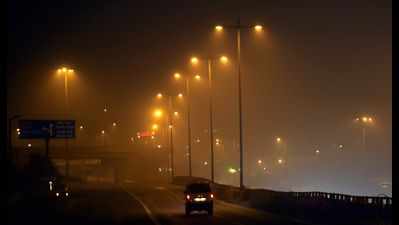- News
- City News
- delhi News
- Delhi's air quality goes from ‘severe’ to ‘very poor’, may get better
Trending
This story is from October 21, 2017
Delhi's air quality goes from ‘severe’ to ‘very poor’, may get better
The Air Quality Index for Delhi fell from 403 on CPCB’s data on Friday to 389 on Saturday. The drop from the “severe” category to “very poor” was, however, accompanied by hazy conditions.

Delhi’s overall AQI hovered at 380-390 on Saturday, though eight air monitoring stations logged pollution in the “severe” category. (File Photo)
Key Highlights
- Delhi’s overall AQI hovered at 380-390 on Saturday, though eight air monitoring stations logged pollution in the “severe” category
- Delhi’s most polluted station on Saturday was Anand Vihar with an AQI of 473 in the evening
NEW DELHI: The Air Quality Index for Delhi fell from 403 on CPCB’s data on Friday to 389 on Saturday. The drop from the “severe” category to “very poor” was, however, accompanied by hazy conditions. However, steps envisaged under the graded response action plan to deal with 48 hours of “severe” pollution may not be triggered with both SAFAR and CPCB indicating improvement ahead.
Delhi’s overall AQI hovered at 380-390 on Saturday, though eight air monitoring stations logged pollution in the “severe” category. These included Anand Vihar, Shadipur, Punjabi Bagh, Delhi Technological University, Mandir Marg, NSIT Dwarka, ITO and RK Puram. The rest of the stations recorded “very poor” air with AQI over 350, according to CPCB’s central control room.
AQI of 4001-500, in the “severe” category, affects healthy people and seriously impacts those with existing diseases. Delhi’s most polluted station on Saturday was Anand Vihar with an AQI of 473 in the evening. Respirable PM2.5 levels logged 600 micrograms per cubic metre, or 10 times the safe standard of 60, while places like Mandir Marg and RK Puram recorded PM2.5 levels seven to eight times the safe standard.
The System of Air Quality and Weather Forecasting and Research (SAFAR) data classified PM2.5 level as “very poor” and the coarser PM10 pollutants as “poor” on Saturday evening, with the prospect of gradual reduction over the next three days from Sunday as the calm air movement catches speed to help disperse the polluting particles caused by Diwali fireworks.
According to the Regional Weather Forecasting Centre (RWFC), the city will see clear skies the wind speed was 0.5 to 1 metre/second. Mist is likely to be present in the mornings, so Delhi could continue seeing the haze-like conditions of the last two days.
“The north-westerly winds are slowly becoming stronger,” pointed out an RWFC official. “The wind speed is expected to increase on Sunday evening and help dispersal of particulate matter and you will start to see a gradual improvement in the air quality.”
Delhi’s overall AQI hovered at 380-390 on Saturday, though eight air monitoring stations logged pollution in the “severe” category. These included Anand Vihar, Shadipur, Punjabi Bagh, Delhi Technological University, Mandir Marg, NSIT Dwarka, ITO and RK Puram. The rest of the stations recorded “very poor” air with AQI over 350, according to CPCB’s central control room.
AQI of 4001-500, in the “severe” category, affects healthy people and seriously impacts those with existing diseases. Delhi’s most polluted station on Saturday was Anand Vihar with an AQI of 473 in the evening. Respirable PM2.5 levels logged 600 micrograms per cubic metre, or 10 times the safe standard of 60, while places like Mandir Marg and RK Puram recorded PM2.5 levels seven to eight times the safe standard.
The System of Air Quality and Weather Forecasting and Research (SAFAR) data classified PM2.5 level as “very poor” and the coarser PM10 pollutants as “poor” on Saturday evening, with the prospect of gradual reduction over the next three days from Sunday as the calm air movement catches speed to help disperse the polluting particles caused by Diwali fireworks.
Dipankar Saha, head of CPCB’s air laboratory, explained that air quality was likely to improve after the next 48 hours because wind speed is expected to pick up. “There is no opening in the south for the winds and this is causing the haze-like conditions in the capital,” said Saha. “The winds are fairly calm at this moment, but improvement is imminent in the next 48.”
According to the Regional Weather Forecasting Centre (RWFC), the city will see clear skies the wind speed was 0.5 to 1 metre/second. Mist is likely to be present in the mornings, so Delhi could continue seeing the haze-like conditions of the last two days.
“The north-westerly winds are slowly becoming stronger,” pointed out an RWFC official. “The wind speed is expected to increase on Sunday evening and help dispersal of particulate matter and you will start to see a gradual improvement in the air quality.”
End of Article
FOLLOW US ON SOCIAL MEDIA










